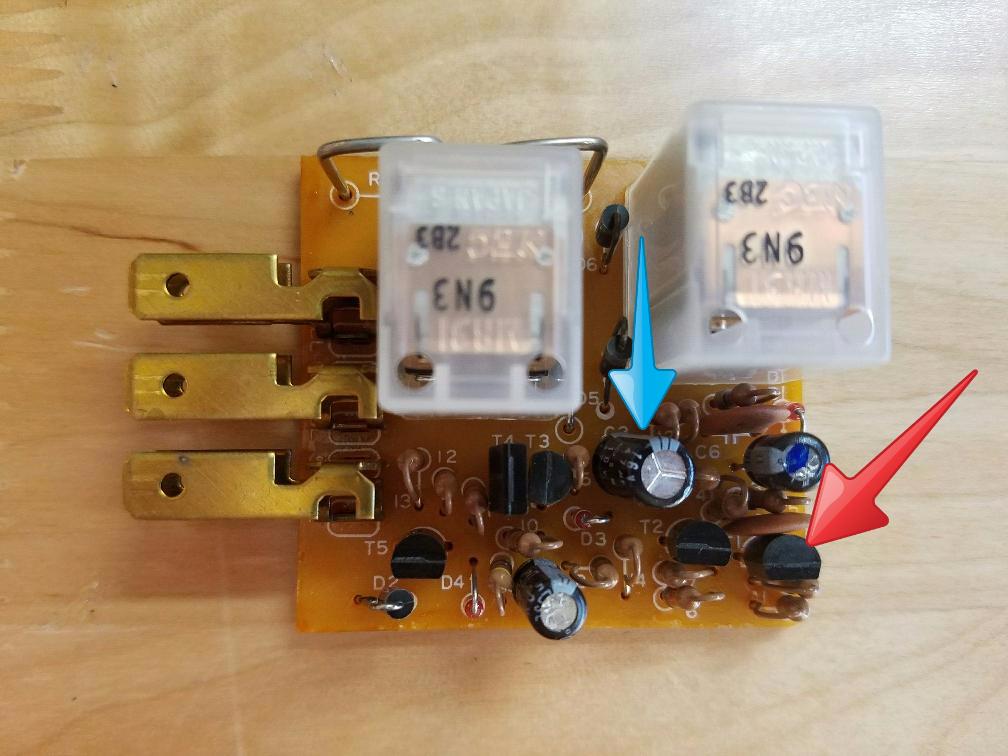- Joined
- 13 August 2015
- Messages
- 114
There's a few mods we do to fix common obstacles when converting the NSX to use LED lighting - accelerated flashing and the brake bulb out warning light on the instrument cluster. Most recently another challenge arose when we released our sequential front turn signals as well as our sequential rear tail lights as some users wanted to alter the speed to either slow down or increase the rate at which the turns flashed. Fortunately these modifications can be accomplished by simply modifying the stock flasher relay.
 Here is the internal view of the flasher relay. The Red arrow points to the transistor responsible for the accelerating the flash during a bulb failure [special thanks to WB9RKN for pointing this out in his post http://www.nsxprime.com/forum/showt...ution/page2?p=1881347&viewfull=1#post1881347]. By simply removing this transistor you will disable the circutiry's logic to detect a burnt out bulb and preserve the stock flash speed.
Here is the internal view of the flasher relay. The Red arrow points to the transistor responsible for the accelerating the flash during a bulb failure [special thanks to WB9RKN for pointing this out in his post http://www.nsxprime.com/forum/showt...ution/page2?p=1881347&viewfull=1#post1881347]. By simply removing this transistor you will disable the circutiry's logic to detect a burnt out bulb and preserve the stock flash speed.
The Blue Arrow points to the capacitor that sets the flash rate of the turn signals - a 16v 47uF Radial Aluminum Electrolytic Capacitor. By simply decreasing the capacitance we can increase the flash rate. By the same logic, increasing the capacitance will slow the flash rate. From testing difference capacitance values I observed the following:
Here's a video of our sequential lights with the stock flash rate configuration:
Here's another video of the sequential lights with a 100uF capacitor:
I hope this helps those who currently have or planning to do sequential turns in the future. If anyone has questions or needs helps sourcing the capacitors let me know. I'd be happy to link you to what will work for you.

The Blue Arrow points to the capacitor that sets the flash rate of the turn signals - a 16v 47uF Radial Aluminum Electrolytic Capacitor. By simply decreasing the capacitance we can increase the flash rate. By the same logic, increasing the capacitance will slow the flash rate. From testing difference capacitance values I observed the following:
- 10uF - Flashes 5 - 10 times per second (yes... 5 to 10 flasher per second) Don't do this unless you're insane.
- 27uF - Flashes 2 times per second and very similar to the accelerated flash when the bulb is out
- 75uF - Flashes become noticeably slower than stock
- 82uF - Probably the sweet spot for sequential lights.
- 100uF - Very very slow. I wouldn't go past 100uF as this was the limit for me where I personally began to think it was too slow.
Here's a video of our sequential lights with the stock flash rate configuration:
Here's another video of the sequential lights with a 100uF capacitor:
I hope this helps those who currently have or planning to do sequential turns in the future. If anyone has questions or needs helps sourcing the capacitors let me know. I'd be happy to link you to what will work for you.

